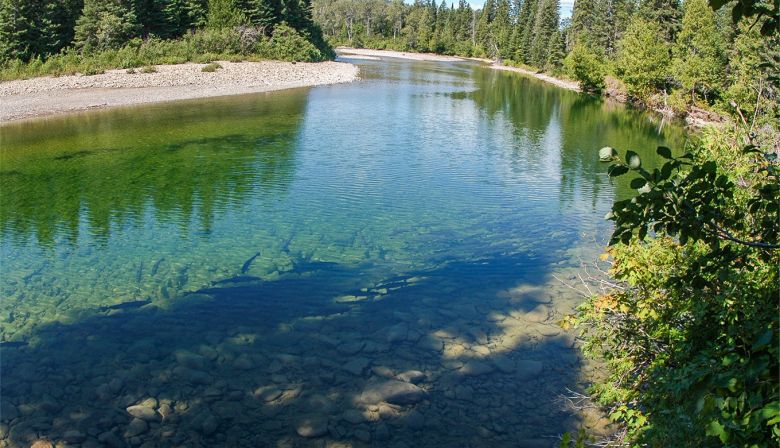
Subscribe & stay up-to-date with ASF

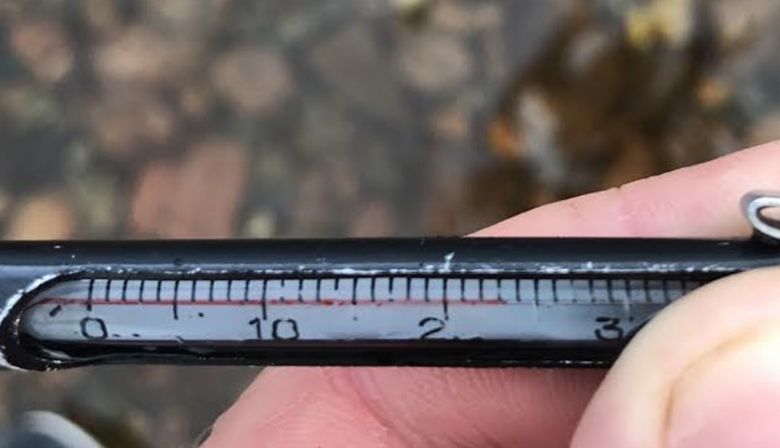
Heat and low water over the last two weeks on the Margaree River have led to questions about DFOs intention and ability to enforce established warm water protocols.
Though the department did announce the closure of two sections as of 4 p.m. today, critics point to evidence that the order should have come sooner.
Here’s a little background: After a heatwave in 2018 forced the closure of a large portion of the Margaree River, DFO partnered with the Nova Scotia government, the Margaree Salmon Association, Nova Scotia Salmon Association, and ASF to develop rules for angling in environmentally stressful conditions.
Studies have shown that mortality rates in Atlantic salmon exercised to exhaustion begin to increase when daily minimum water temperatures climb over 20 C. In-season temperature related closures happen elsewhere in Eastern Canada and are respected by the conservation community.
A warm water protocol for the Margaree came into effect last year. Using a remote sensor in the lower river, DFO is supposed to monitor temperatures. When the daily minimum water temperature is greater than 20 degrees for 48-hours, lower sections of the river are closed until conditions improve. When minimums exceed 23 C for two days at the monitoring site, the normally cold Northeast branch of the river is off limits to all angling.
This year, DFO had troubles activating the monitoring station, and when it did become operational, communication and logistical issues popped up.
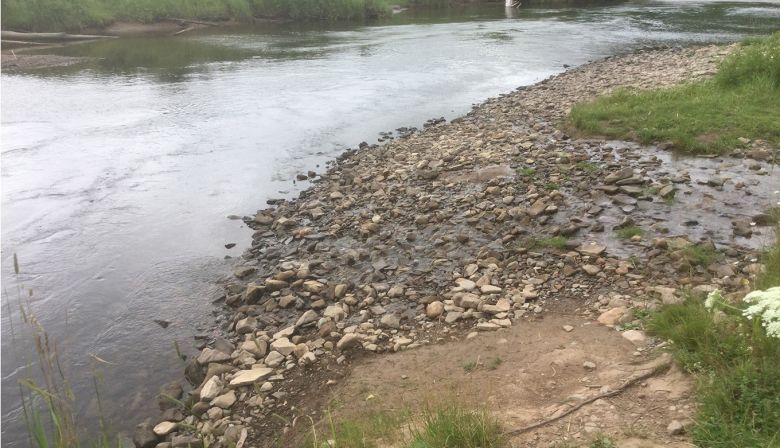
According to Alex Breckenridge, owner of the Tying Scotsman fly shop, DFO fumbled their response to summer conditions on the river, exposing salmon to increased risk. He believes the warm water closure should have taken effect weeks ago. “The lower Margaree River is wide open with no coverage as it runs through the valley. After a full day of sunshine the water temperatures are at times 25 C. by late afternoon. The air temperature at the house most days has been 28-30,” Breckenridge reported to RiverNotes.
All the partners in the Margaree cold water protocol have a role in alerting DFO to temperature related concerns, but Breckenridge feels the Margaree Salmon Association, closest to the river, has not been assertive when it comes to warm water.
In New Brunswick, warm water protocols exist on the Miramichi, Restigouche, and Nepisiguit systems. They are efficiently turned on and off as conditions dictate, although their design and implementation did include hiccups and minor controversy.
In Newfoundland and Labrador (See Don Ivany’s report below) and the Margaree, protocols are newer and seem to be experiencing growing pains. For such measures to be effective they must be acted upon. These measures are broadly understood and accepted by the salmon angling community, so the only thing in DFO’s way is themselves.
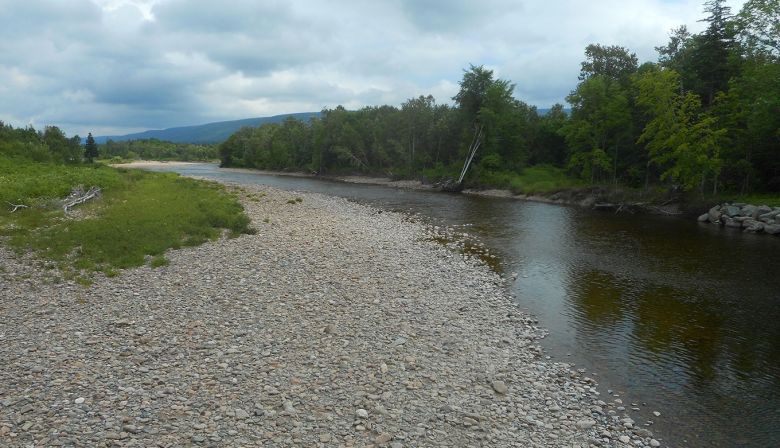
“While the Barney’s River, Pictou, has held its water reasonably well, many other streams are very low and warm in Nova Scotia. The brooks around Antigonish are in desperate need of rain and even though we have had a few nights that are cooler, they are still sitting right around 20 degrees early in the morning.“
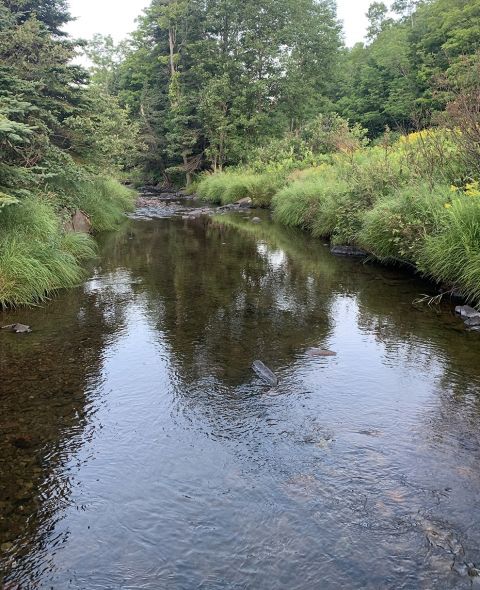

“At the half-way point of the 2020 season, counts by way of in-river assessments and data from fish counting infrastructure have been tabulated to determine if numbers indicate a harvest can take place as of August 1. Many rivers benefited from a spike in river levels and flows thanks to rain happening during the last few days of July.
“The Matane river saw a rush of fish migrate into the river when over 500 fish were counted during two days on July 31st and August 1st.
“The data used for the Quebec river notes are sourced from various river websites, social media and Quebec government sources. Information can change without prior notification regarding prior year comparative figures.”

Nous sommes déjà rendus à la mi-saison 2020. Les décomptes ont eu lieu récemment afin de déterminer l’abondance de la montaison jusqu’à ce jour. Les rivières qui vont avoir atteint ou sont en voie d’atteindre leur seuil optimal de déposition d’œufs pourront permettre la récolte de grand saumon. De nombreuses rivières ont bénéficié d’un bon montant de précipitation pendant les derniers jours de juillet.
La rivière Matane a vu une ruée de poissons migrer dans la rivière lorsque plus de 500 poissons ont été dénombrés pendant deux jours le 31 juillet et le 1er août.
Les données utilisées dans ce rapport proviennent de divers sites Web, médias sociaux et des sources du gouvernement du Québec.
Depuis le 1er août, les prises de grands saumons ont été autorisées conformément au plan de gestion provincial sur les rivières suivantes où une évaluation est possible:

As of August 1, harvests of large salmon have been authorized as per the provincial management plan on the following rivers where assessment is possible. See list below.
Depuis le 1er août, les prises de grands saumons ont été autorisées conformément au plan de gestion provincial sur les rivières suivantes où une évaluation est possible:
Région Gaspésie/Gaspé Region :
Rivière Dartmouth River
Rivière Madeleine River
Rivière Sainte-Anne River
Rivière Saint-Jean River
Rivière York River
Région Bas-Saint-Laurent / Lower St-Lawrence Region:
Rivière Matane River
Rivière Matapédia River
Rivière Mitis & Mistigougèche Rivers
Région Côte-Nord/North Shore Region:
Rivière du Gros Mécatina River
Rivière Napetipi River
Rivière Saint-Paul River
Rivière du Vieux Fort River
Rivières York, Dartmouth, St-Jean Rivers
Most recent catch statistics are available at:
https://saumongaspe.com/en/peche-saumon-gaspe/statistiques.html
Les statistiques récentes des prises peuvent être consultées au :
https://saumongaspe.com/peche-saumon-gaspe/statistiques.html
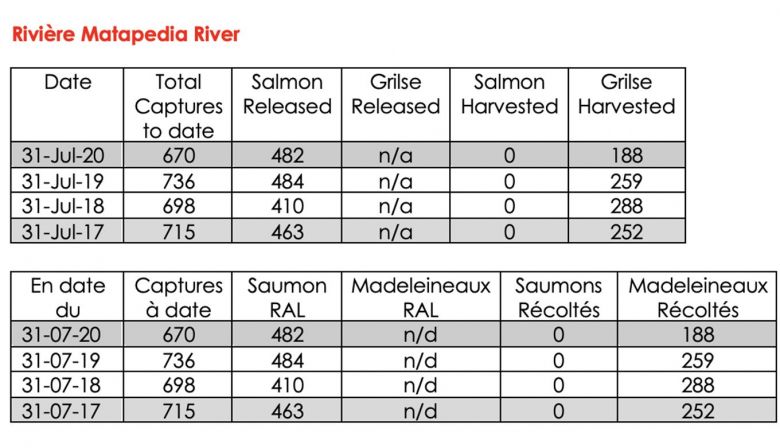
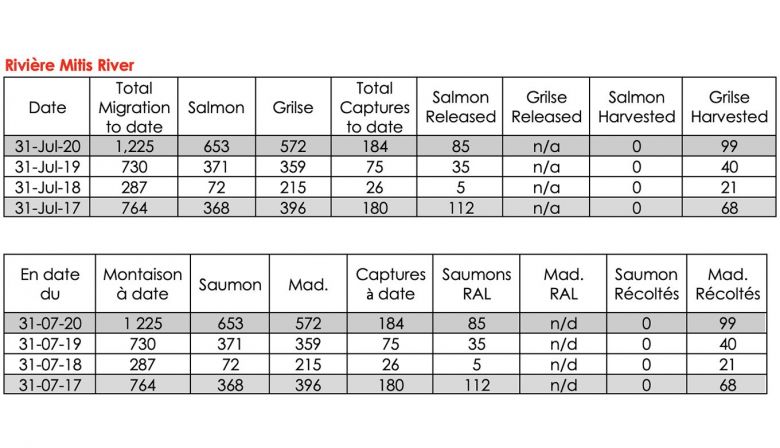


The Cascapedia River angling success continued during the last week benefiting from the bump in water.
Visit https://www.facebook.com/Micmac-Camp-199352133438454/ to see the great action anglers are having.
Le succès de pêche est très bon considérant les conditions difficiles que les pêcheurs ont dû faire face récemment.
Visitez le site Facebook ci-haut pour avoir un aperçu de l’action vécu depuis la dernière semaine.
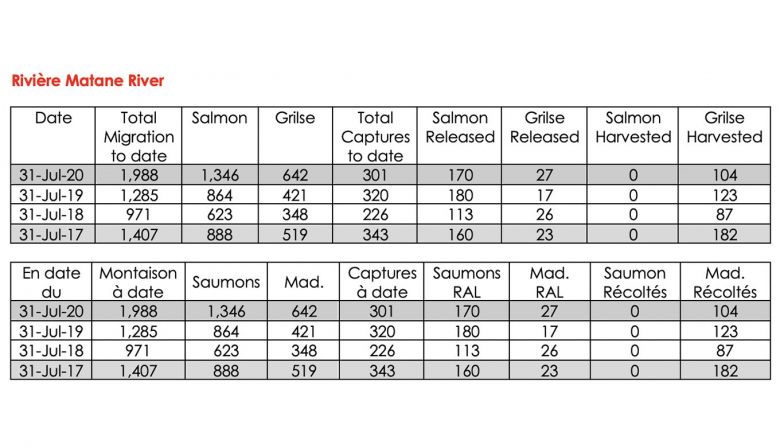



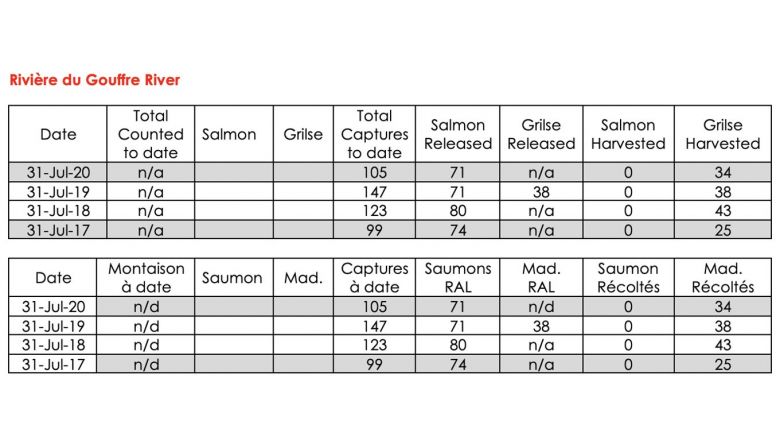
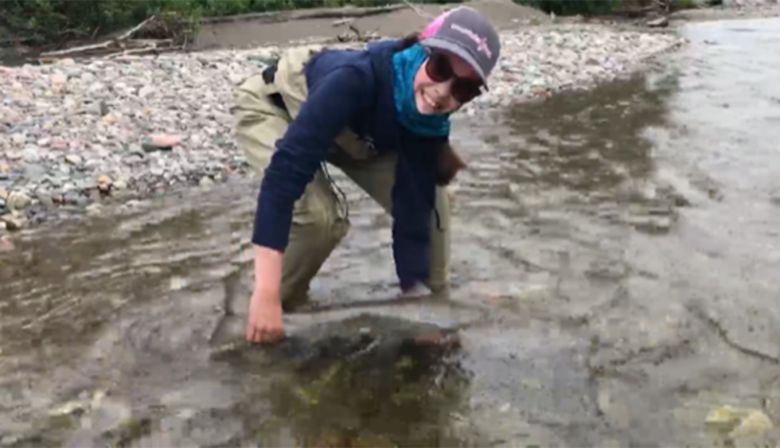
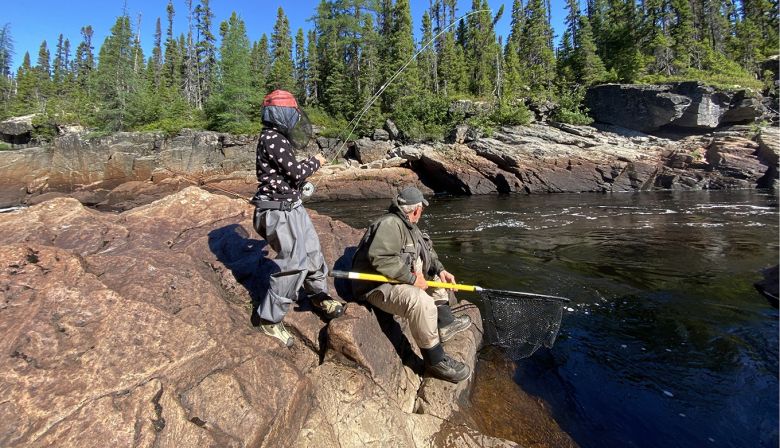
Most rivers throughout NL are still experiencing warm temperatures and fishing has been spotty at best for the past week. Where there are fish, anglers are reporting they appear to be lazy and are often difficult to entice to the fly. During these warm water conditions we encourage anglers to monitor water temperatures closely and follow protocols.
To remain up to date on warm water closures in Newfoundland and Labrador visit: https://inter-j01.dfo-mpo.gc.ca/isrs/report
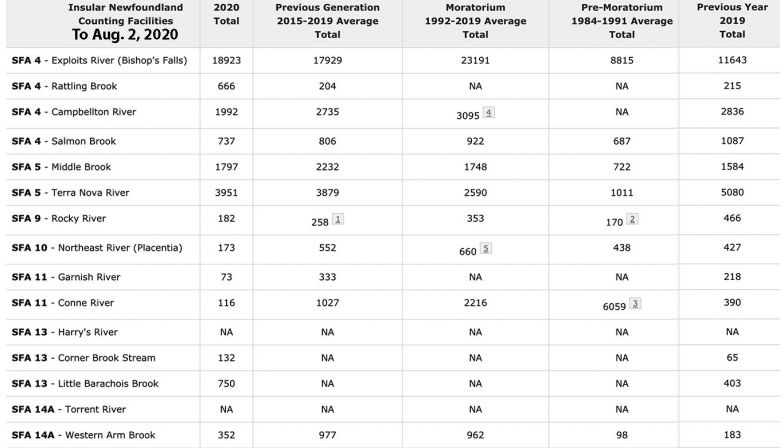
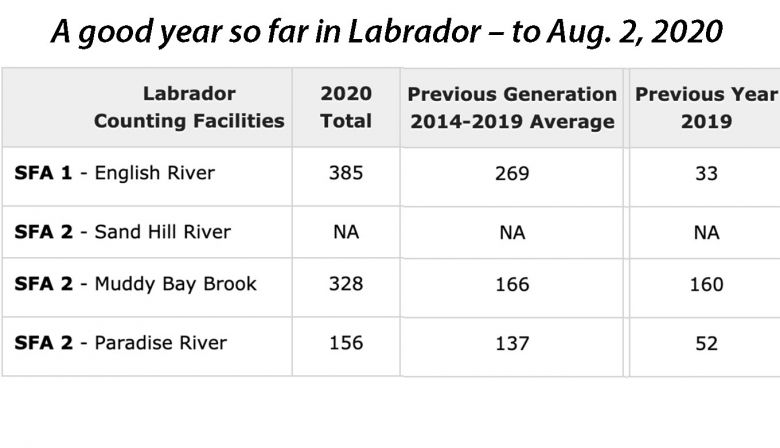
Chris Verbiski notes on the Lewis and the Hunt rivers:
We closed the action on the Lewis River a few weeks ago, hence no additional information.
The Hunt experienced a strong new moon run and as of this update the full moon peak of run has yet to develop. Longest logbook lag is four days post full moon and hopefully a break in the extremely warm daytime temperatures will have the run resuming. Despite warm air temperatures, water temperatures are peaking at 14 C during the daytime.
Northern Labrador
Mike Crosby, from Flowers River Lodge reports:
The water at Flowers River is on the low side and the temperature is creeping up due to an extended period of abnormally warm sunny weather. Having said that, I just flew into Flowers and there is still snow in the hills and our guests, to a person, all came to me to say what an excellent trip they had. There are good numbers of fish and good numbers of 20 pound plus fish.
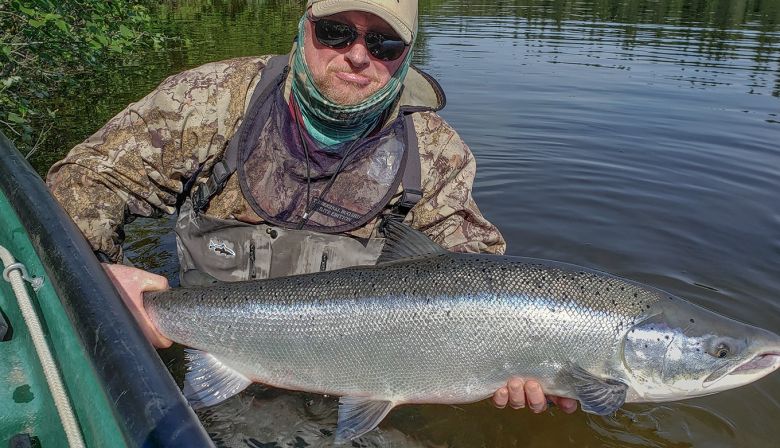
Southwestern Newfoundland
Once again water levels are very low on most Bay St. George Rivers and water temperatures are very warm.
Not surprisingly angling has been very slow and anglers are wondering why these rivers have not been closed by DFO under the circumstances.
Likewise, conditions are not good on the Upper Humber where fishing also remains slow at the moment. However, there are encouraging reports from the Lower Humber for the past week or so.
Brad Andrews reports a good sign of fish at the outlet of Deer Lake known as Boom Siding. He says there is a good mix of grilse and large salmon in this area at the moment, and he has hooked several fish there during the past week.
Note: the lower Humber is well known for its late season run of large fish, so if angling conditions hold firm in this section of the river, we can expect more good angling there over the next few weeks.
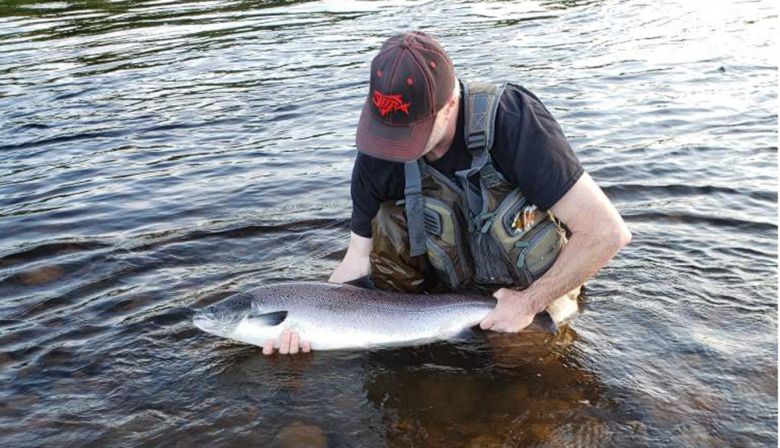
Reports are that anglers were still hooking the odd fish on both the Exploits River and Gander River during the past week. However, warm water conditions have really slowed the action from what it has been prior to that, and fewer fish are being seen. In the Glenwood area what fish are being seen are dark and appear to have been in the river for awhile.
Long time angler and Board Member of the Freshwater Alexander Bay Ecosystem Corporation (FABEC), Ken McClean, reports that while water levels on the Terra Nova River are still not that bad and fish are still being seen, water temperatures are warm and fish are almost impossible to entice to the fly. Ken reports that he has seen a noticeable decrease in fish in the rivers that he fishes in the Central NL area during the past week or so.
South Coast
Heavy rain over the past week-end caused water levels to rise quickly on a number of rivers on the South coast including Grey River and LePoile River. As a result, angling success improved slightly but warm water temperature is still an issue.
Avalon Peninsula
Heavy rain during the around the middle of July caused high water levels on most rivers on the Avalon Peninsula making angling difficult. Since then water levels have receded and anglers have been enjoying some success. However, fishing remains somewhat spotty overall.
In closing most rivers in the province need rain desperately and we can use some cool temperatures. Unfortunately, there is more sunny weather in the forecast for most of the province for the next week or so. That said, night time air temperatures are starting to cool which may help moderate water temperatures to some degree on some rivers.
From Rick Maddigan on the Salmonier:
After we got back from Castors – July 12 – the rivers on the Avalon were quite low with poor fishing. Since then we have had two good, heavy bouts of rain. The first, in mid-July, flushed out those fish that were held up in the rivers and produced good fishing for about a week. Many of the fish caught had been in the rivers for a while.
The second, near the end of July, coincided with the full moon and brought in the last of the fresh fish and also resulted in relatively good fishing, considering it was August.
The rivers are falling quickly again now and there is no rain in the forecast so things do not look good for the the short term but all in all it has been a good year. It is pretty well over here now and the one thing that was most obvious to everyone this year was the significant increase in the number of anglers on the rivers. Many said they were ” working from home.”

Corner Brook Stream
Keith Piercey writes on Thursday:
WE HAVE A NEW RECORD (Well, the salmon do! :O) ) As of this evening the total release at the Corner Brook Stream trap is 153 – two more than the previous record. Every one from now on is another one for the record books.
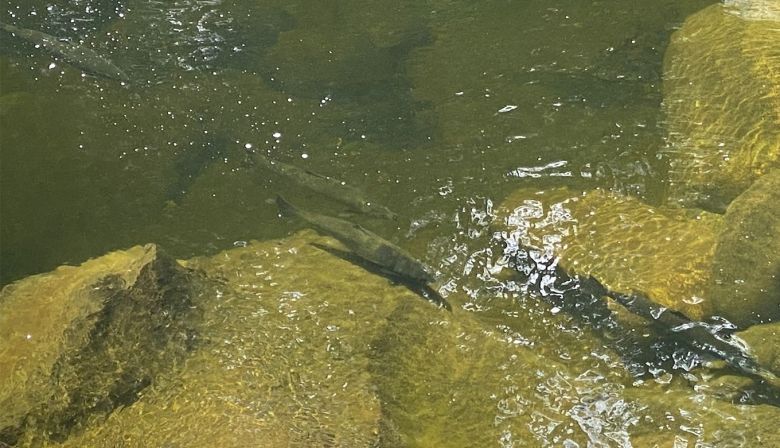
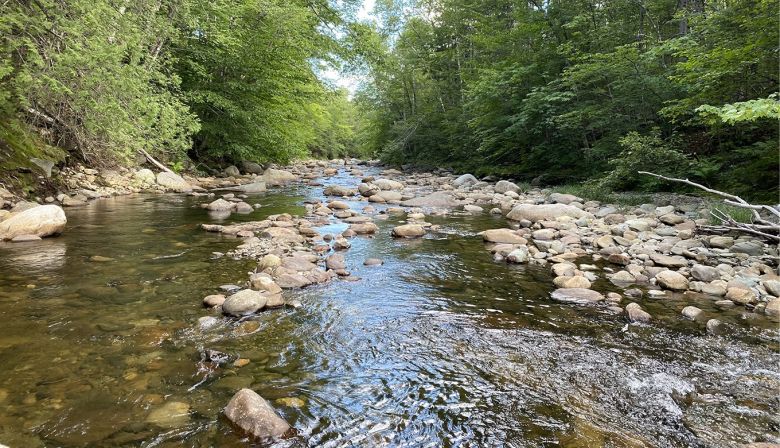
Maine has been feeling the heat, just as the rest of the Atlantic salmon range in North America has been.
But in the western part of the state the tropical storm Isaias has made a contribution, with water levels going up after it roared by on its way to Quebec early Wednesday morning.
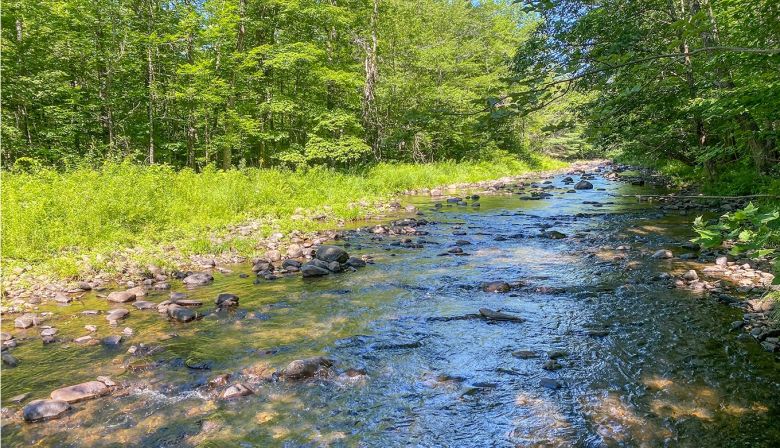
The Maine Headwaters Project is getting work done during this year of Covid 19. Every culvert that doesn’t pass fish is an important issue for Atlantic salmon and other migratory fish.
A stream crossing on Clover Mill Road near Farmington is just such a project. A cold water stream invaluable for restoration has been clogged by a poor culvert. See first photo below.
This is being replaced with a 14-foot open span.
As Maranda Nemeth describes the present project, as seen in the second photo:
Clover Mill Road in Farmington . The existing cold water stream is not seen in this photo as it is currently pumped and routed around the work site. EL Vining received the contract after a competitive bid to his past spring. The work includes installing a new open- bottom metal arch with a 14 foot open span, an upgrade for the stream and road from the previous four-foot round pipe. The crew is installing rebar that will reinforce a concrete support wall for the metal arch.
Once finished, the road will no longer flood over and the stream can move naturally along its path to Temple Stream. The Walton’s Mill Dam slated to be removed is just a few miles downstream.
The work is a part of the greater Temple Stream watershed restoration in the Maine Headwaters Project.

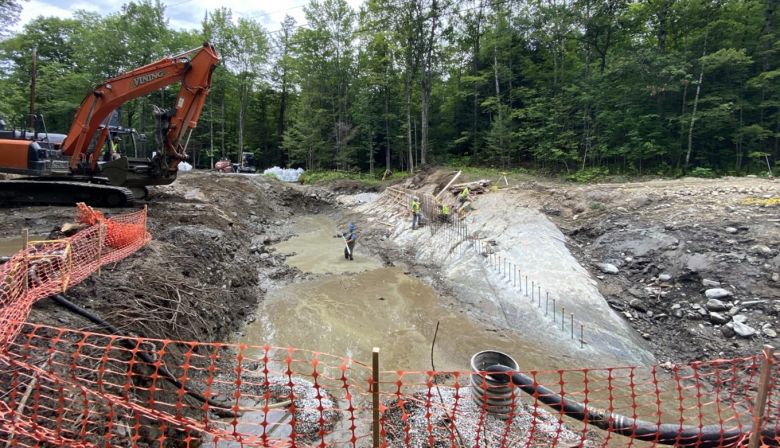
Emma Christman, summer intern, described her work on the Kennebec in the last week.
Last Tuesday worked with the Maine Department of Marine Resources staff to canoe the Kennebec River from Sidney to Augusta and create two temperature profiles of the river, as well as mapping the temperature influence of smaller tributaries as they meet the mainstem. This stretch of river is not heavily developed on the shoreline, other than a gravel mining company blasting near Augusta. It was fantastic to see the character of this segment of the river’s mainstem.
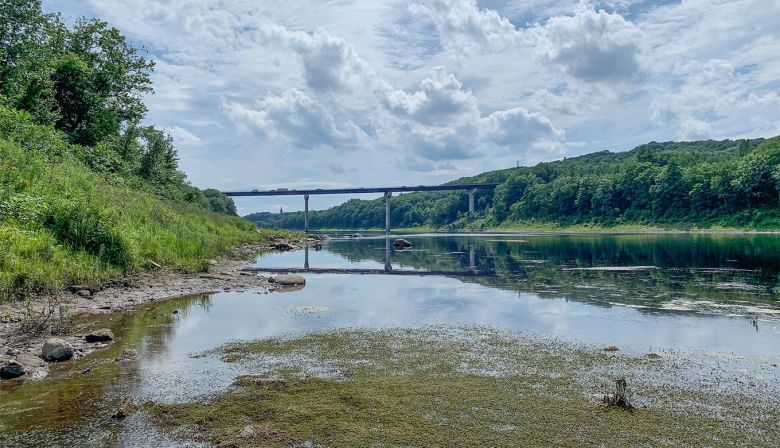
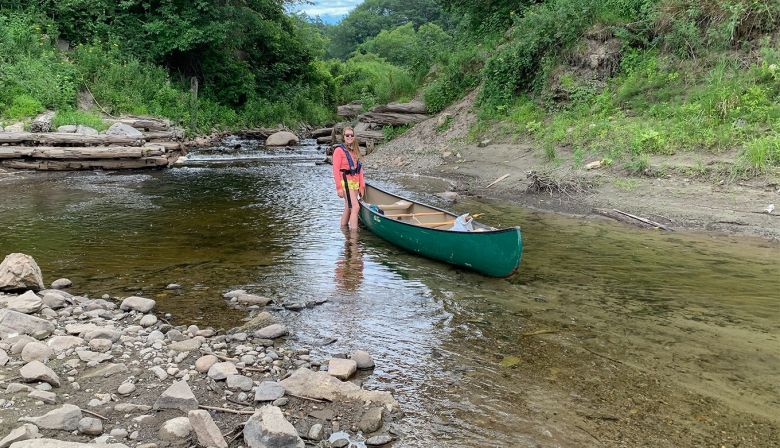
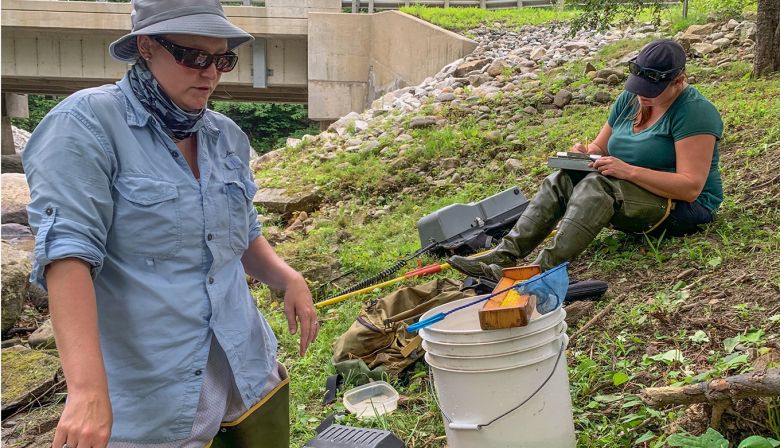
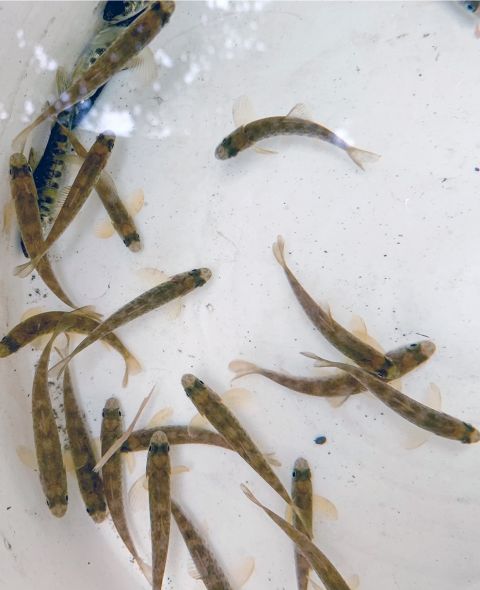
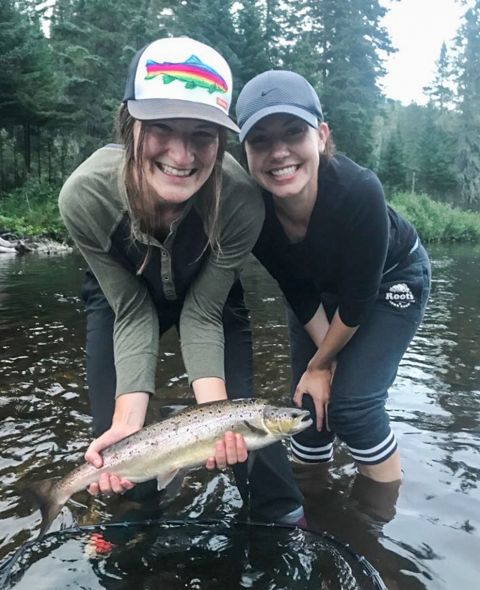

Nathan Wilbur, ASF Director of New Brunswick Programs writes:
I’m sure most anglers and farmers around the province were crossing their fingers that we’d get the remnants of hurricane Isaias to bring some wet weather to he region. That didn’t materialize but at least we got a modest bump of water last weekend on the Miramichi, Restigouche and other salmon rivers draining from the centre of the province.
That cooled things off and provided good fishing in certain areas. We have been hearing good reports from people up and down the rivers – locals, camp staff, guides – all seeing more fish moving upriver and holding in the pools than they’ve seen in years.
Since there are more fish around, any window of good water conditions should produce some nice fishing opportunities.
I have been in Bathurst for a few days and salmon are jumping out in the Bay de Chaleur eager to get upriver in the Nepisiguit, but waiting for higher flows and cooler weather just like us.
Over the next few weeks, keep an eye on the warm water protocol status on the Miramichi, Restigouche, and Nepisiguit rivers, and once late August comes around with cooler nights we should be in the clear for the rest of the season.
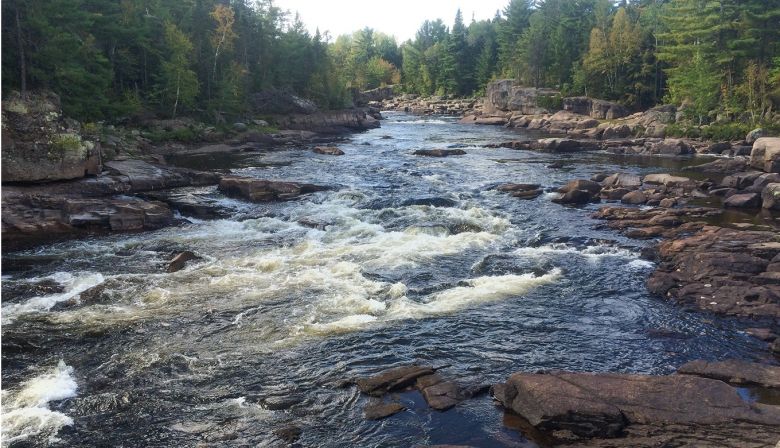
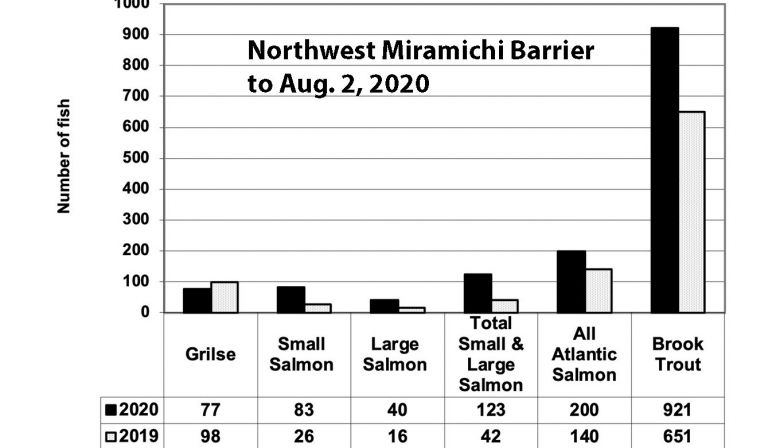
Northwest Miramichi
DFO’s latest counts, to Aug. 2, show the encouraging numbers of large salmon.
Dungarvon Barrier
The numbers are much in line with last year. To Aug. 2, 77 grilse and 70 large salmon this year, vs. 78 grilse and 65 large salmon last year.